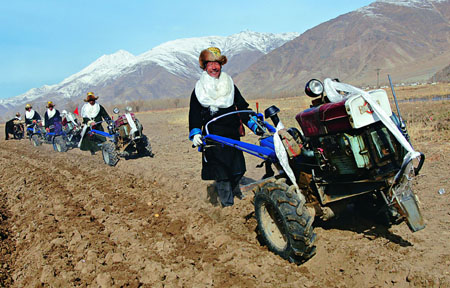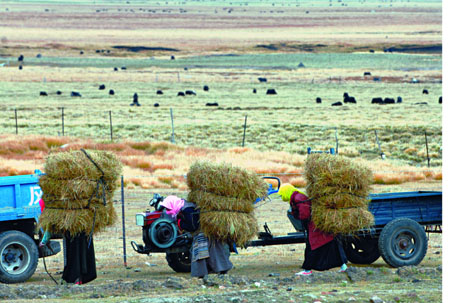| As the leading industries in Tibet, agriculture and animal husbandry have weak foundations due to factors related to history and nature. Especially restricted by poor traffic conditions, most of the local characteristic agricultural and livestock products seldom enter the national market. The opening of the Qinghai-Tibet Railway greatly reduces the distance between Tibet and the hinterland, providing unprecedented opportunity for promoting development of Tibet's characteristic agriculture and speeding up the access of agricultural products to the market. In 2006, the total output value of agriculture, forestry, animal husbandry and fishery reached 7.375 billion Yuan (up 6.3 percent), of which that of agriculture was 3.230 billion Yuan (up 6 percent) and that of animal husbandry 3.208 billion Yuan (up 9.5 percent).
Under the precondition of stable grain output, Tibet in recent years has increased the growth of high quality and yield crops, fodder and cash crops. Currently, besides traditional agriculture and animal husbandry, farmers and herdsmen also take the chance of the opening of the Qinghai-Tibet Railway, directly taking part in the tourist industry so as to increase the income. In 2006, 29,000 farmers and herdsmen participated in tourist services, an increase of 49 percent over 2005, with per capita income reaching 5,318 Yuan, up 153 percent.
Agriculture
In the transformation from traditional to modern agriculture, Tibet is vigorously developing efficient agriculture depending on new science and technology. This is increasing the unit production of grains and oil and the utilization rate of agricultural resources and leading the agricultural economy into a favorable situation. In 2006, farmland sown to cereals reached 179,165 hectares, some 6,030 hectares less than the previous year. Of this, farmland sown to qingke barley reached 116,280 hectares, a decrease of 3,990 hectares; that to wheat 41,490 hectares, a fall of 510 hectares; that to rape 24, 050 hectares, a decrease of 2,000 hectares; that to vegetables 18,990 hectares, an increase of 950 hectares. Grain production in 2006 reached 923,700 tons, a fall of 1.1 percent from the previous year; production of rapeseeds was 54,500 tons, a fall of 10.9 percent; production of vegetables was 450,000 tons, an increase of 4.8 percent. The grain production of per unit area amounted to 387 kg, an average increase of 45 kg per hectare, and the agricultural output value was 3.230 billion Yuan, up 6 percent.

Busy spring ploughing
In recent years, Tibet also attaches great importance to the development of special agricultural and animal husbandry industries, establishing seven special industrial belts, which has helped the agricultural and animal husbandry economy maintain an increase speed of over 5 percent for three straight years. In 2006, Tibet allocated a special fund of 240 million Yuan to develop the special agricultural and animal husbandry projects. As a result, 364,000 farmers and herders benefited from it, enjoying a per capita increased income of 660 Yuan. Meanwhile, Tibet also underscored the training for new-type farmers and herders, allocating 40 million Yuan; 257,000 person times of instructors, farmers and herders gained training, through which their integrated quality and skills were improved.?
Most of the major grain production zones are distributed in arid and semi-arid zones, featuring the typical irrigation-depending agriculture. Hence, the key point of improving the production condition of agriculture and animal husbandry is to accelerate the construction of irrigation area and improve the irrigation level. In 2006, Tibet carried out three projects covering the Manla, Moda and Yarlung irrigation sectors in the drainage areas of the Nyangqu River, Lhasa River and Yarlung River, adding and improving 5,333 hectares of irrigated farmland.
In 2007, 44 special industrial projects of agriculture and animal husbandry in the construction plan of Tibet were to be put into operation, covering seven prefectures (cities) and 50 counties (cities and regions), with a total investment of some 360 million Yuan, of which State investment accounts for 61.07 percent. Thus, Tibet will create a number of major enterprises of agriculture and animal husbandry and famous brands of characteristic agricultural and livestock products, further improving the comprehensive productive capacity and market competitive power of agriculture and animal husbandry.?
Animal Husbandry
Tibet abounds in animal husbandry resources, boasting not only grasslands in great variety but also plains, farmland and suburbs. The industrial belt of breeding cashmere goat, yak, Tibetan sheep, pig and chicken and milch cow will play a major role in the development of animal husbandry, providing more green products. In 2006, animal husbandry maintained stable development. The total production value reached 3.208 billion Yuan, 44 percent of the agriculture, forestry, animal husbandry and fishery of the region. At the end of 2006, Tibet had 24.36 million head of domestic animals in stock, an increase of 210,000 head over the previous year. They included 6.51 million cows (an increase of 190,000), and 17.03 million sheep (an increase of 50,000). In the year, the output of pork, beef and mutton reached 222,100 tons, an increase of 3.5 percent and that of milk 276,100 tons, an increase of 2.3 percent. The per capita amount of meat and milk reached 77.48 kg and 97.48 kg.

Herders in northern Tibet making preparation for the animals to tide over the freezing winter
Forestry
In 2006, the Tibet Autonomous Region planted 18,470 hectares of trees. This included 1,840 hectares of timber forest, 8,820 hectares of economic forest and 6,230 hectares of protection forest. The region produced more than 20,000 tons of various nuts and fruit, and manufactured and sold over 1,500 tons of forest products. The cumulative total output of forestry added up to 1.78 billion Yuan, and the farmers and herders gained an increased income of 550 million Yuan through the construction of forestry projects. With the opening of the Qinghai-Tibet Railway and Nyingchi and Ngari Airports, the forest eco-tourism will become the new economic growth point of Tibet, and the opening of the wild animals' domestication is expected to become the new focus of forestry economic growth in Tibet. |





